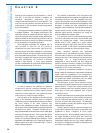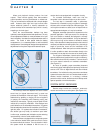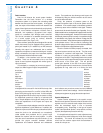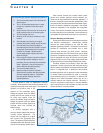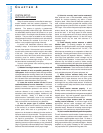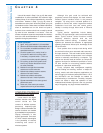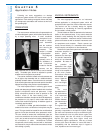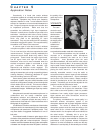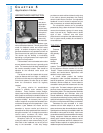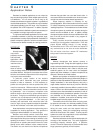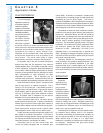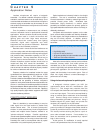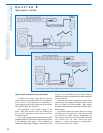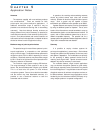
Following are some suggestions on wireless
microphone system selection and use for some specific
applications. Each section gives typical choices and setup
for microphones, transmitters and receivers as well as a
few operating tips.
PRESENTERS
The most common wireless choice for presentations is
a lavaliere/bodypack system, which allows hands-free use
by a single speaking voice. A small condenser
microphone is con-
nected to a body-
pack transmitter
and the combina-
tion is worn by the
presenter. The
receiver is located
in a fixed position.
The bodypack
transmitter is
generally worn at
the waistband or
belt. It should be
located so that the
antenna can be
freely extended and so that the controls can be reached
easily. Transmitter gain should be adjusted to provide
suitable level for the particular presenter.
The receiver should be located so that its antennas are
line of sight to the transmitter and at a suitable distance,
preferably at least 5 meters. Once the receiver is connected
to the sound system the output level and squelch should be
adjusted according to the previous recommendations.
The most important factor in achieving good sound
quality and adequate gain-before-feedback with a lavaliere
system is microphone choice and placement. A high
quality microphone placed as close as practical to the
wearers’ mouth is the best starting point. An
omnidirectional lavaliere microphone should be attached to
the presenter on a tie, lapel or other location within 8-10
inches of the mouth for best pickup. A headworn type is an
increasingly popular option.
In situations of limited gain-before-feedback or high
ambient noise levels a unidirectional microphone may be
used. This type should be located like the omnidirectional
type but it must also be aimed at the presenter’s mouth.
The user should be aware that unidirectional types are
much more sensitive to wind noise and breath blasts (k’s,
t’s, d’s, etc.) as well as noise from clothing rubbing against
the microphone or cable. Unidirectional lavaliere
microphones should always be used with a windscreen
and mounted in a way to reduce direct mechanical contact
with clothing or jewelry.
MUSICAL INSTRUMENTS
The most appropriate choice for an instrument
wireless application is a bodypack system, which will
accept the audio signal from various instrument sources.
The receiver can be a diversity design for highest
performance or non-diversity for economy applications
and is located in a fixed position.
The transmitter can often be attached to the instrument
itself or to the instrument strap. In any case it should be
located to avoid interfering with the player but with its
controls accessible. Instrument sources include electric
guitars and basses as well as acoustic instruments such
as saxophones and trumpets. Electric sources can
usually connect directly to a transmitter while acoustic
sources require a microphone or other transducer.
Receivers for instrument systems are connected to an
instrument amplifier for
electric guitars and
basses or to a mixer input
for acoustic instruments,
which are not otherwise
amplified. Be aware of
the potential for
interference from digital
effects processors in the
vicinity of the amplifier or
at the mixer position.
Connections should be
well-shielded and
secure. Again the
usual distance
and line-of-sight
considerations
apply.
The most
important factor in
the performance
of an instrument
system is the
interface between
the instrument and
the transmitter.
The signals from
electric instruments fitted with magnetic pickups are
generally comparable to microphone signals, though
the levels and impedances may be somewhat higher.
Other transducers such as piezo-electric types have
output signals that also are similar to microphone
signals but again may have higher levels and
substantially higher impedances. With any of these
sources care should be taken to insure that there is
compatibility with the transmitter input in regard to
level, impedance and connector type.
Selection
and Operation
of Wireless Microphone Systems
46
C HAPTER 5
Application Notes



